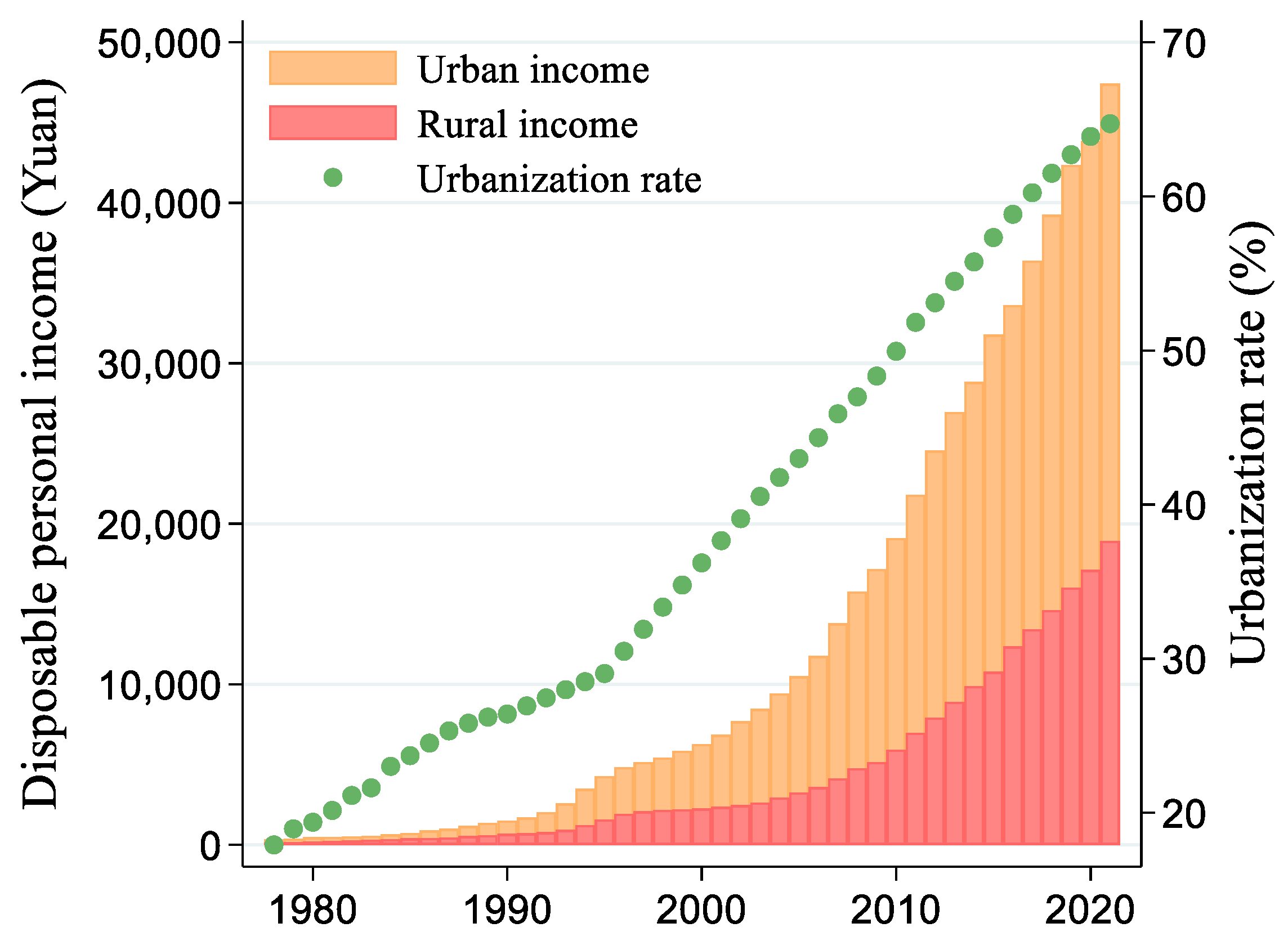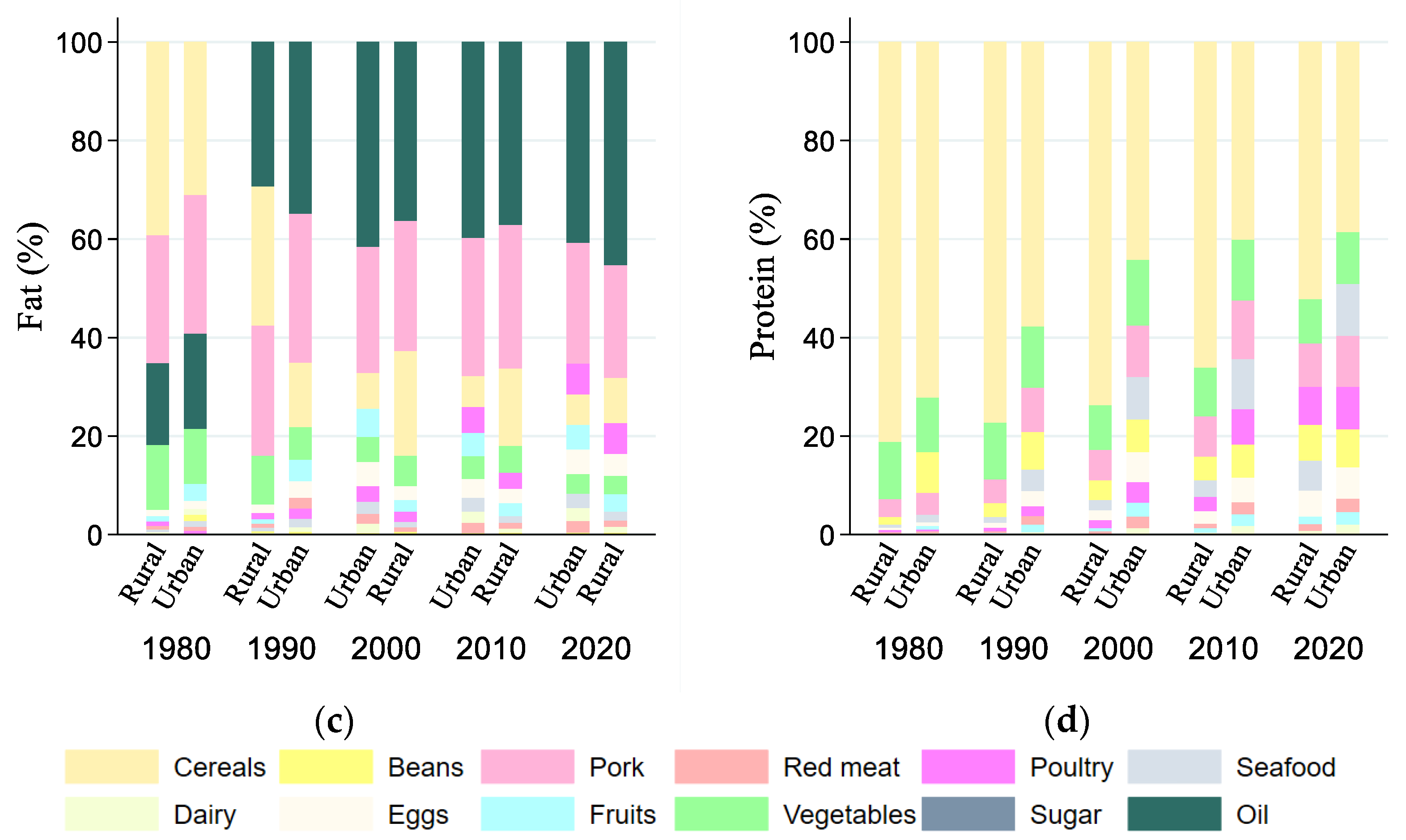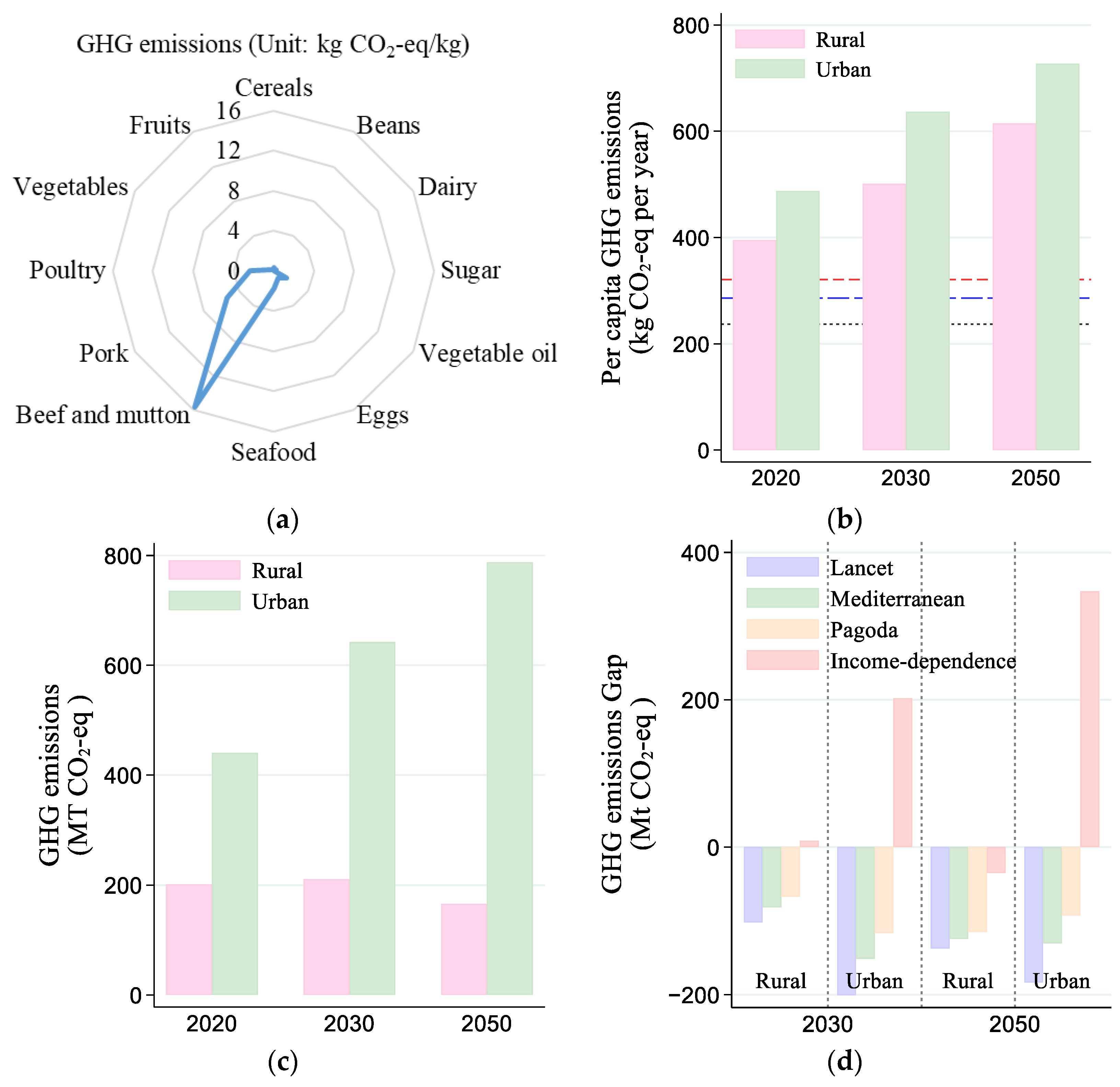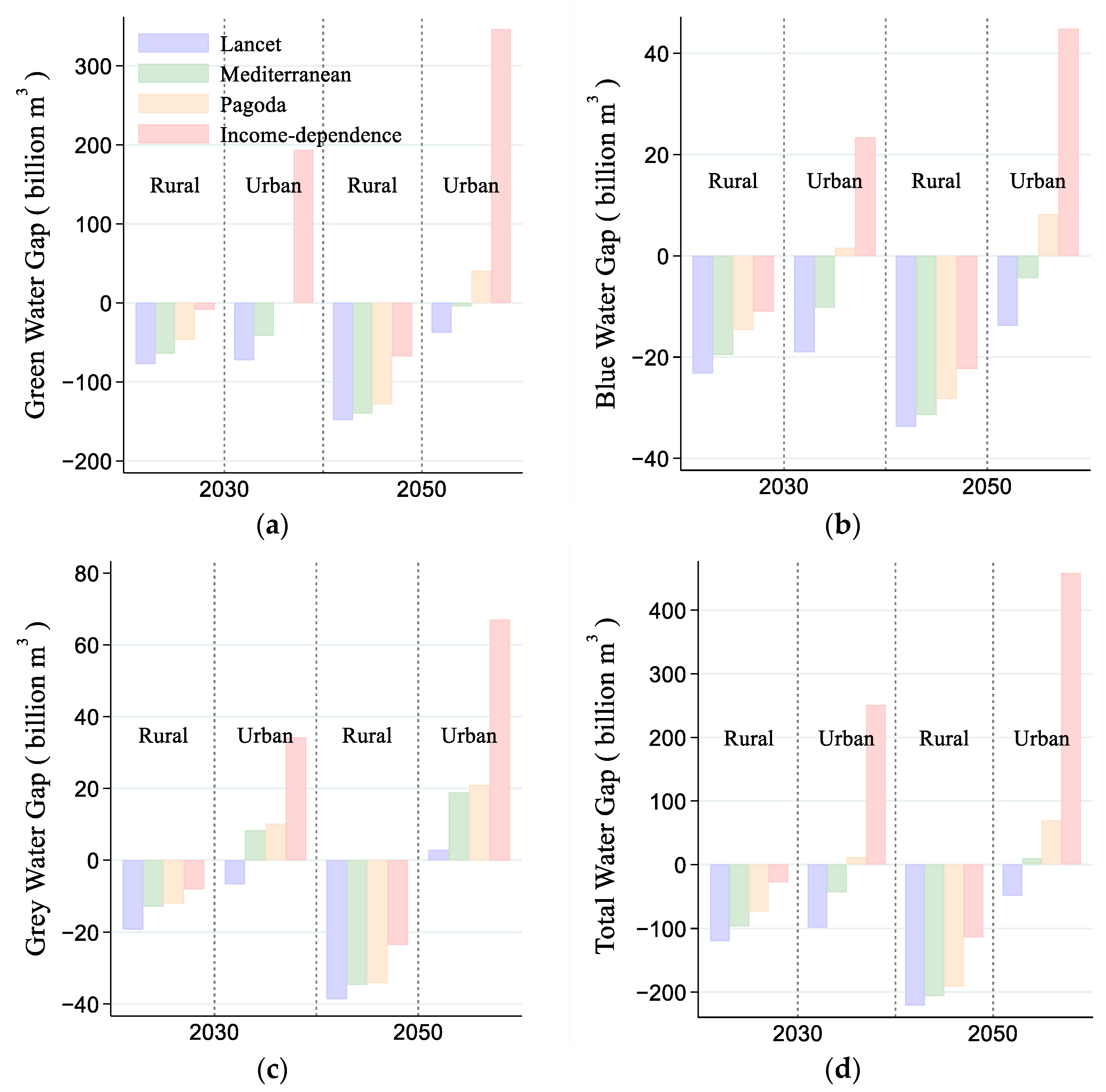Future Dietary Transformation and Its Impacts on the Environment in China
Abstract
:1. Introduction
2. Materials and Methods
2.1. Food Consumption and Nutrition
2.2. Environmental Impacts of Different Diets
2.3. Different Alternative Diet Scenarios
3. Results and Discussion
3.1. Evaluation of the Current Dietary Nutrition Status in China
3.2. Future Dietary Transition and Nutritional Implications in China
3.3. GHG Emissions Impacts of Meeting Future Dietary Transition in China
3.4. Water Footprint Impacts of Meeting Future Dietary Transition in China
3.5. Arable Land Requirement of Future Food Consumption in China
4. Limitations Analysis
5. Conclusions and Policy Implications
- (1)
- Overall, the combination of food consumption trends and urban–rural population mobility may bring pressure to the future domestic food supply. China’s agricultural supply should pay more attention to the production of livestock products and the guarantee and adequacy of feed supply as well as the issue of meat product import trade.
- (2)
- This research indicated that the burden of the dietary environment in China will further increase in the future, especially in urban areas, but rural areas will significantly decrease with a decrease in population size, based on the premise of maintaining the current dietary development trend. Fortunately, the negative population growth in China in the medium to long term will have a restraining effect on it.
- (3)
- Based on the current impact of the dietary environment in China, the three alternative dietary scenarios will significantly reduce the overall burden of the dietary environment in the future. The Chinese Dietary Pagoda is an optional dietary scenario that reflects the dietary preferences of Chinese residents. According to the Chinese Dietary Pagoda scenario, urban inhabitants’ overall dietary carbon emissions will be lower than the benchmark level in the future, while their demand for arable land and water will be higher than the benchmark level.
- (4)
- In addition to accelerating the progress of agricultural technology, improving agricultural productivity, continuing to build high-standard farmland, expanding the development of grassland agriculture and marine agriculture, and actively utilizing the international market to moderately import feed grains can help alleviate the environmental pressure of future food demand. At the same time, guiding the public to reduce food loss and waste is also beneficial for reducing environmental impacts.
Author Contributions
Funding
Institutional Review Board Statement
Informed Consent Statement
Data Availability Statement
Conflicts of Interest
References
- Shenggen, F.; Wenjin, L.; Xiaolong, F.; Wei, S.; Yu, S. The UN Food Systems Summit and Chinese Strategy. Issues Agric. Econ. 2022, 3, 4–16. [Google Scholar]
- Marlow, H.J.; Hayes, W.K.; Soret, S.; Carter, R.L.; Schwab, E.R.; Sabate, J. Diet and the environment: Does what you eat matter? Am. J. Clin. Nutr. 2009, 89, 1699S–1703S. [Google Scholar] [CrossRef] [PubMed]
- Jiang, L.; Seto, K.C.; Bai, J. Urban economic development, changes in food consumption patterns and land requirements for food production in China. China Agric. Econ. Rev. 2015, 7, 240–261. [Google Scholar] [CrossRef]
- Hawkins, J.; Ma, C.; Schilizzi, S.; Zhang, F. China’s changing diet and its impacts on greenhouse gas emissions: An index decomposition analysis. Aust. J. Agric. Resour. Econ. 2017, 62, 45–64. [Google Scholar] [CrossRef]
- Zhen, L.; Du, B. Ecological Footprint Analysis Based on Changing Food Consumption in a Poorly Developed Area of China. Sustainability 2017, 9, 1323. [Google Scholar] [CrossRef]
- Zhang, Y.; Tian, Q.; Hu, H.; Yu, M. Water Footprint of Food Consumption by Chinese Residents. Int. J. Environ. Res. Public Health 2019, 16, 3979. [Google Scholar] [CrossRef]
- He, G.; Geng, C.; Zhai, J.; Zhao, Y.; Wang, Q.; Jiang, S.; Zhu, Y.; Wang, L. Impact of food consumption patterns change on agricultural water requirements: An urban-rural comparison in China. Agric. Water Manag. 2021, 243, 106504. [Google Scholar] [CrossRef]
- Su, B.; Zhang, C.; Martens, P.; Cao, X. A comparative study on the dietary ecological footprint in contemporary China. Sci. Total Environ. 2022, 851, 158289. [Google Scholar] [CrossRef]
- Zhang, H.; Xu, Y.; Lahr, M. The greenhouse gas footprints of China’s food production and consumption (1987–2017). J. Environ. Manag. 2022, 301, 113934. [Google Scholar] [CrossRef]
- China Agricultural University (AGFEP) Academy of Global Food Economics and Policy; Zhejiang University (CARD) China Academy for Rural Development; Nanjing Agricultural University (CIFAE) Centre for International Food and Agricultural Economics; Chinese Academy of Agricultural Sciences (IAED) Institute of Agricultural Economics and Development; International Food Policy Research Institute (IFPRI). 2021 China and Global Food Policy Report: Rethinking AGRIFOOD systems for the Post-COVID World; China Agricultural University (AGFEP): Beijing, China, 2021. [Google Scholar]
- Liangjie, X.I.N.; Biesbroek, S.; Jiayue, W.; Lixin, W. Prospect of per capita grain demand driven by dietary structure change in China. Resour. Sci. 2015, 37, 1347–1356. [Google Scholar]
- Hua-jun, T.; Zhe-min, L.I. Study on Per Capita Grain Demand Based on Chinese Reasonable Dietary Pattern. Sci. Agric. Sin. 2012, 45, 2315–2327. [Google Scholar]
- Tilman, D.; Clark, M. Global diets link environmental sustainability and human health. Nature 2014, 515, 518–522. [Google Scholar] [CrossRef]
- Mekonnen, M.; Hoekstra, A.Y. National Water Footprint Accounts: The Green, Blue and Grey Water Footprint of Production and Consumption; Unesco-IHE Institute for Water Education: Delft, The Netherlands, 2011. [Google Scholar]
- Cai, H.; Biesbroek, S.; Wen, X.; Fan, S.; van ’t Veer, P.; Talsma, E.F. Environmental footprints of Chinese foods and beverages: Literature-based construction of a LCA database. Data Brief 2022, 42, 108244. [Google Scholar] [CrossRef]
- Chaudhary, A.; Gustafson, D.; Mathys, A. Multi-indicator sustainability assessment of global food systems. Nat. Commun. 2018, 9, 848. [Google Scholar] [CrossRef]
- Berners-Lee, M.; Hoolohan, C.; Cammack, H.; Hewitt, C.N. The relative greenhouse gas impacts of realistic dietary choices. Energy Policy 2012, 43, 184–190. [Google Scholar] [CrossRef]
- Davis, K.F.; Gephart, J.A.; Emery, K.A.; Leach, A.M.; Galloway, J.N.; D’Odorico, P. Meeting future food demand with current agricultural resources. Glob. Environ. Chang. 2016, 39, 125–132. [Google Scholar] [CrossRef]
- Martinez-Gonzalez, M.A.; Hershey, M.S.; Zazpe, I.; Trichopoulou, A. Transferability of the Mediterranean Diet to Non-Mediterranean Countries. What Is and What Is Not the Mediterranean Diet. Nutrients 2017, 9, 1226. [Google Scholar] [CrossRef]
- Trichopoulou, A.; Martinez-Gonzalez, M.A.; Tong, T.Y.N.; Forouhi, N.G.; Khandelwal, S.; Prabhakaran, D.; Mozaffarian, D.; de Lorgeril, M. Definitions and potential health benefits of the Mediterranean diet: Views from experts around the world. BMC Med. 2014, 12, 112. [Google Scholar] [CrossRef]
- Willett, W.; Rockström, J.; Loken, B.; Springmann, M.; Lang, T.; Vermeulen, S.; Garnett, T.; Tilman, D.; DeClerck, F.; Wood, A.; et al. Food in the Anthropocene: The EAT–Lancet Commission on healthy diets from sustainable food systems. Lancet 2019, 393, 447–492. [Google Scholar] [CrossRef]
- Hirvonen, K.; Bai, Y.; Headey, D.; Masters, W.A. Affordability of the EAT-Lancet reference diet: A global analysis. Lancet Glob. Health 2020, 8, e59–e66. [Google Scholar] [CrossRef]
- Crippa, M.; Solazzo, E.; Guizzardi, D.; Monforti-Ferrario, F.; Tubiello, F.N.; Leip, A. Food systems are responsible for a third of global anthropogenic GHG emissions. Nat. Food 2021, 2, 198–209. [Google Scholar] [CrossRef]
- Wang, J.; Feng, L.; Palmer, P.I.; Liu, Y.; Fang, S.; Bösch, H.; O’Dell, C.W.; Tang, X.; Yang, D.; Liu, L.; et al. Large Chinese land carbon sink estimated from atmospheric carbon dioxide data. Nature 2020, 586, 720–723. [Google Scholar] [CrossRef]
- Yan, D.; Wu, S.; Tang, Y.; Zhu, J.; Zhou, S.; Xu, Z. Arable land and water footprints for food consumption in China: From the perspective of urban and rural dietary change. Sci. Total Environ. 2022, 838, 155749. [Google Scholar] [CrossRef]








| Diet | Current | Income-Dependence 2030 | Income-Dependence 2050 | |||
|---|---|---|---|---|---|---|
| (kg cap−1 yr−1) | Urban | Rural | Urban | Rural | Urban | Rural |
| Cereals | 146.8 | 188.7 | 127.6 | 146.7 | 126.5 | 145.5 |
| Beans | 15.6 | 14.1 | 12.6 | 14.7 | 12.6 | 17.1 |
| Dairy | 21.6 | 10.6 | 27.3 | 16.5 | 28.9 | 18.5 |
| Vegetable Oil | 11.9 | 11.9 | 12.5 | 15.5 | 12.6 | 19.6 |
| Eggs | 16.9 | 13.9 | 20.8 | 18.6 | 24.2 | 25.8 |
| Seafood | 23.7 | 14.7 | 37.0 | 18.8 | 45.6 | 25 |
| Beef | 7.5 | 4.2 | 10.4 | 5.3 | 12.2 | 6.5 |
| Pork | 27.1 | 23.1 | 38.2 | 35.8 | 41.9 | 43.1 |
| Poultry | 18.6 | 17.7 | 32.2 | 24.7 | 43.9 | 38.3 |
| Vegetables | 131.7 | 111.4 | 98.8 | 104.6 | 89.2 | 104.6 |
| Fruits | 70.7 | 44.3 | 85.6 | 69.5 | 94.3 | 84.1 |
| Total | 492.2 | 454.6 | 503.1 | 470.9 | 531.9 | 528.2 |
| Food Item | 2020 | 2030 | 2050 | |||
|---|---|---|---|---|---|---|
| Urban | Rural | Urban | Rural | Urban | Rural | |
| Cereals | 45.1023 | 32.7672 | 43.8253 | 20.9663 | 46.6242 | 13.3833 |
| Beans | 0.9514 | 0.4860 | 0.8596 | 0.4166 | 0.9219 | 0.3122 |
| Dairy | 6.5868 | 1.8269 | 9.3144 | 2.3437 | 10.5722 | 1.6890 |
| Vegetable Oil | 15.4456 | 8.7297 | 18.1725 | 9.3826 | 19.6189 | 7.6162 |
| Eggs | 12.5043 | 5.8127 | 17.2522 | 6.3978 | 21.4800 | 5.7150 |
| Seafood | 37.2906 | 13.0726 | 65.0316 | 13.7912 | 86.0724 | 11.7766 |
| Beef and Mutton | 106.0991 | 33.5811 | 164.3046 | 34.8729 | 207.0421 | 27.5291 |
| Pork | 129.4857 | 62.3820 | 204.2485 | 79.6428 | 240.1678 | 61.6535 |
| Poultry | 39.6493 | 21.3251 | 76.7939 | 24.5163 | 112.2626 | 24.4427 |
| Vegetables | 40.9375 | 19.5711 | 34.3618 | 15.1244 | 33.2620 | 9.7341 |
| Fruits | 5.8596 | 2.0752 | 7.9386 | 2.6786 | 9.3759 | 2.0868 |
| Food Item | Current Value | Income-Dependence | Three Alternative Diets | ||||||
|---|---|---|---|---|---|---|---|---|---|
| 2020 | 2030 | 2050 | Mediterranean | EAT–Lancet | Pagoda | ||||
| Urban | Rural | Urban | Rural | Urban | Rural | ||||
| Cereals | 257 | 330 | 223 | 257 | 221 | 255 | 166 | 180 | 208 |
| Beans | 15 | 13 | 12 | 14 | 12 | 16 | 17 | 26 | 10 |
| Dairy | 46 | 23 | 58 | 35 | 62 | 40 | 195 | 195 | 235 |
| Vegetable Oil | 73 | 73 | 77 | 95 | 77 | 120 | 104 | 104 | 61 |
| Eggs | 28 | 23 | 34 | 31 | 40 | 43 | 17 | 8 | 26 |
| Seafood | 120 | 75 | 188 | 96 | 232 | 127 | 132 | 51 | 107 |
| Beef and Mutton | 179 | 100 | 247 | 126 | 290 | 155 | 48 | 71 | 71 |
| Pork | 99 | 85 | 140 | 132 | 154 | 158 | 7 | 11 | 44 |
| Poultry | 60 | 57 | 103 | 79 | 140 | 123 | 19 | 35 | 22 |
| Vegetables | 149 | 126 | 112 | 118 | 101 | 118 | 247 | 124 | 165 |
| Fruits | 68 | 43 | 82 | 67 | 91 | 81 | 88 | 70 | 96 |
| Total | 1093 | 947 | 1277 | 1049 | 1420 | 1235 | 1041 | 876 | 1047 |
| Food Item | Current Value | Income-Dependence | ||||
|---|---|---|---|---|---|---|
| 2020 | 2030 | 2050 | ||||
| Urban | Rural | Urban | Rural | Urban | Rural | |
| Cereals | 23.1776 | 16.8387 | 22.5214 | 10.7743 | 23.9597 | 6.8775 |
| Beans | 1.3371 | 0.6830 | 1.2080 | 0.5855 | 1.2955 | 0.4388 |
| Dairy | 4.1703 | 1.1567 | 5.8973 | 1.4839 | 6.6937 | 1.0693 |
| Vegetable Oil | 6.5813 | 3.7197 | 7.7433 | 3.9979 | 8.3596 | 3.2453 |
| Eggs | 2.5158 | 1.1695 | 3.4711 | 1.2872 | 4.3217 | 1.1498 |
| Seafood | 10.8622 | 3.8079 | 18.9427 | 4.0172 | 25.0716 | 3.4303 |
| Beef and Mutton | 16.1043 | 5.0971 | 24.9391 | 5.2932 | 31.4260 | 4.1785 |
| Pork | 8.9730 | 4.3229 | 14.1539 | 5.5191 | 16.6430 | 4.2724 |
| Poultry | 5.3699 | 2.8882 | 10.4006 | 3.3204 | 15.2043 | 3.3104 |
| Vegetables | 13.4267 | 6.4189 | 11.2700 | 4.9605 | 10.9093 | 3.1926 |
| Fruits | 6.1234 | 2.1686 | 8.2960 | 2.7992 | 9.7980 | 2.1807 |
| Total | 98.6417 | 48.2712 | 128.8433 | 44.0383 | 153.6823 | 33.3458 |
Disclaimer/Publisher’s Note: The statements, opinions and data contained in all publications are solely those of the individual author(s) and contributor(s) and not of MDPI and/or the editor(s). MDPI and/or the editor(s) disclaim responsibility for any injury to people or property resulting from any ideas, methods, instructions or products referred to in the content. |
© 2023 by the authors. Licensee MDPI, Basel, Switzerland. This article is an open access article distributed under the terms and conditions of the Creative Commons Attribution (CC BY) license (https://creativecommons.org/licenses/by/4.0/).
Share and Cite
Sun, H.; Zhu, B.; Cao, Q. Future Dietary Transformation and Its Impacts on the Environment in China. Sustainability 2023, 15, 13021. https://doi.org/10.3390/su151713021
Sun H, Zhu B, Cao Q. Future Dietary Transformation and Its Impacts on the Environment in China. Sustainability. 2023; 15(17):13021. https://doi.org/10.3390/su151713021
Chicago/Turabian StyleSun, Hongjie, Benzheng Zhu, and Qingqing Cao. 2023. "Future Dietary Transformation and Its Impacts on the Environment in China" Sustainability 15, no. 17: 13021. https://doi.org/10.3390/su151713021
APA StyleSun, H., Zhu, B., & Cao, Q. (2023). Future Dietary Transformation and Its Impacts on the Environment in China. Sustainability, 15(17), 13021. https://doi.org/10.3390/su151713021








